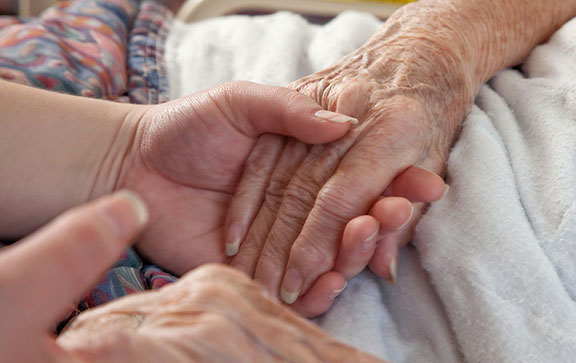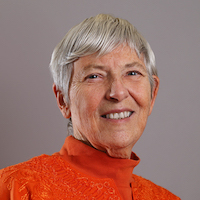 Swami Sarvaananda is a monastic disciple (sannyasi) of Sri Swami Satchidananda and the first board certified Hindu chaplain in the United States. Initiated as a monk and an Integral Yoga minister in 1977, she became a chaplain in 2001. Chaplains often serve in hospitals, hospice, the military, with police and disaster teams. In this interview, she shares what inspires her to serve as a sannyasi and chaplain.
Swami Sarvaananda is a monastic disciple (sannyasi) of Sri Swami Satchidananda and the first board certified Hindu chaplain in the United States. Initiated as a monk and an Integral Yoga minister in 1977, she became a chaplain in 2001. Chaplains often serve in hospitals, hospice, the military, with police and disaster teams. In this interview, she shares what inspires her to serve as a sannyasi and chaplain.
Integral Yoga Magazine: How did you meet Swami Satchidananda and why did you decide to become a swami?
Swami Sarvaananda: When I was 28, I first saw Swami Satchidananda, whom we call “Gurudev.” I was attending a public program and there was a teenage boy seated in the audience who was visibly disturbed and agitated. When Gurudev walked into the hall, the boy suddenly became so peaceful. I saw the power of the Holy Spirit in action that day (how I described it to my Protestant friends), and I knew I wanted more of that. I had to get past the “guru” issue as many westerners do. But, I knew I wanted to find peace within and I looked around until I saw the person who had the most peace and was the happiest person—even when things weren’t going so well. And that is what I found in Swami Satchidananda. He said that you don’t have to pray outside to God, you could just be very quiet and feel God within. That was a major change in philosophy for me, and I knew right away that was for me. I had to get myself ready to hear, feel and do it myself.
I always felt a strong pull to spiritual life and community. When I was a child, I wanted to go and live in a kibbutz (a Jewish spiritual community), but we weren’t Jewish! I grew up Protestant, so I wasn’t going to go the Catholic route of becoming a nun. I had already had a very deep relationship with God, and I knew that my life was to follow a path of giving myself to God in order to serve others. I knew I had to clean my own act up first. I considered that to be the beginning of learning how to undo. The path of sannyas for me is truly about selfless service. It took me many years to believe that one could actually be selfless and altruistic when serving.
IYM: Are there differences between being a swami and a chaplain or minister?
SS: The key to excellent chaplaincy and success in sannyas is serving others’ needs, not our own. Gurudev helped me to know how to assess those needs and not judge the people I am serving. He taught me to ask myself, “How is the action I want to take of benefit to someone and no harm to anyone.” I have to assess myself and the situation, and then I can find a peaceful, easeful, and useful answer. The difference between a sannyasi and a minister is very simple. I have no family for whom I am directly responsible. While often both put in long hours, I don’t have to divide my time between chaplaincy and family life. I do have personal responsibilities, but I have more flexibility in terms of when I do them. I don’t have kids and family waiting for me to get home. I have to pray to be sure I am doing the most important service that I need to be doing at any given time. I believe I am a steward of what I have. As a monk, I don’t own anything but use everything I have been given for the benefit of the ashram and humanity.
IYM: What do chaplains do?
SS: Chaplains serve the patient and the patient’s family by finding out what gives the family hope, what are the family cultural, religious and spiritual traditions and, using those traditions to support the people through whatever situations they encounter. Chaplains do not impose their own views. Rather, they have the knowledge and skills to support the person’s own beliefs and can assist the patient in re-defining their beliefs when under stress. All chaplains are skilled in counseling basics and many are certified counselors. Most have additional training in Crisis Intervention Stress Management (CISM), Conflict Mediation, Disaster Response and more. When I finished training, I stayed on as an adjunct staff chaplain and eventually made my way over to Hospice of the Piedmont (HOP). There, I continued as a chaplain and then as a full-time chaplain supervisor position at HOP. I have since retired from that position, but continue to serve as a consultant there and UVA, as well as other organizations. I also give talks and lead trainings on death and dying, grief and recovery. Additionally, I coordinate end-of-life healthcare for Satchidananda Ashram – Yogaville residents, conduct memorial and other services.
IYM: What led you to become a chaplain?
SS: It seemed to be in my nature to work with people. I’ve always loved service. In terms of chaplaincy, I had some acquaintances that were ill and needed hospice. I found it easy to serve them with their end-of-life issues. In 1988, I learned about chaplaincy and immediately applied and was accepted for a University of Virginia (UVA) hospital internship. Then, I took two years of residency training, with the second year being a specialty in cancer and palliative care. I found that serving patients, in the ways that they needed (rather than in the ways I thought they needed to be served!) was very familiar to me, mainly because this unconditional service is a foundational principle of Sri Gurudev’s teachings. I knew I had a lot to learn in technique, but I knew I was home in terms of the level of selfless service required—it had been what Gurudev had been training me for.
UVA took a great leap in accepting me into the program because previously they had only taken interns from Judeo-Christian religions. Every day was a day of translation. The simplest of concepts for the Christians and Jews had to be explained to me and the simplest of Yoga principles such as karma had to be explained to them. A number of years later, my internship supervisor told me that translating what she believed, so it could be understood by a different faith tradition, was the hardest challenge she had faced.
IYM: What about the hardest challenge you faced?
SS: One of the hardest was preparing a sermon because in our tradition we really don’t preach or testify. I didn’t even know what testify meant! What my fellow interns and I found was that if we could find a common language and approached each other with love, we could accomplish anything. I always use the TEAM acronym: Together Everyone Achieves Miracles. Probably most difficult for the others in the program was understanding my ability to accept all religions and faiths as valid paths to God. It was second nature for me to accept and respect all faith traditions.
IYM: How did you prepare yourself to do hospice work and what sustains you as you continue to serve?
SS: My goal is to keep myself peaceful so I can serve better. I gratefully utilize all the practices of Yoga to keep myself balanced. Each day, the minute I get into my car, I turn on Gurudev’s affirmations (on the “Guided Relaxation” CD). He begins with, “You are happiness personified” and ends with how we can be one spiritually. The last thing Gurudev says on the CD is, “Thank you.” I take that as a message that I can’t serve without thanking the people I serve for the opportunity to serve them. Swami Sivananda always taught to “be good, do good, love all and serve all.” I took that and made my license plate “love and serve” to remind myself to love and serve unconditionally.
Another thing is that whenever I need to respond to a situation, I ask myself what Gurudev would do and what his teachings say that will allow me to be peaceful and to easefully serve this person. I can’t serve them, unless I am peaceful. I’m so grateful for all of Gurudev’s aphorisms and sutras that come to my mind like little gems. The essence of my being is infused with Gurudev’s motto: “Truth is one, paths are many.” If I can respect everyone’s path, I can serve them where they are. The older I get, the more I realize that serving them where they are is the most important thing. This has been instilled in me from living in the Ashram for over four decades. I feel it’s important to come back to the monastery and my community at the end of a day of teaching, counseling, etc. When I’m with like-minded people and those I love the most, I know I can count on them to challenge me so I can live the teachings in a better manner.
IYM: What Yoga or other practices do you find most useful to share with patients?
SS: The main practices are deep relaxation and pranayama because many I work with are near death, can’t move or are on assisted breathing. The breath allows the body, mind and spirit to relax. Sometimes I say to the family members, “Let’s all take slow, deep breaths as we hold hands.” The patient may join in and our breath becomes a rhythm—it’s one of the most holy situations I have ever experienced. I’ve seen people die with a smile on their face because we’ve done this together.
Also, a phrase I often employ is: Think twice before saying nothing. I will ask myself a series of questions: Is what I want to say useful? Do I need to be the person to say it? Do I improve on silence by speaking? This is particularly important when you are working with very ill people. Being present is so important.
About Swami Sarvaananda, Ph.D., M.C.C.:
 Swami Sarvaananda is the former chaplaincy supervisor for Hospice of the Piedmont, a nonprofit agency that serves 11 counties in Central Virginia. She was also instrumental in developing the Yogaville Vidyalayam (Integral Yoga School), “Christmas in Buckingham” program and served as administrator of Satchidananda Ashram. In her “spare” time, she wrote the “Extra Gentle Yoga” and “Arthritis and Yoga” training manuals for the Integral Yoga Academy and the Arthritis Association. Swami Sarvaananda also contributed a chapter to the new book: Hindu Approaches to Spiritual Care: Chaplaincy in Theory and Practice.
Swami Sarvaananda is the former chaplaincy supervisor for Hospice of the Piedmont, a nonprofit agency that serves 11 counties in Central Virginia. She was also instrumental in developing the Yogaville Vidyalayam (Integral Yoga School), “Christmas in Buckingham” program and served as administrator of Satchidananda Ashram. In her “spare” time, she wrote the “Extra Gentle Yoga” and “Arthritis and Yoga” training manuals for the Integral Yoga Academy and the Arthritis Association. Swami Sarvaananda also contributed a chapter to the new book: Hindu Approaches to Spiritual Care: Chaplaincy in Theory and Practice.

